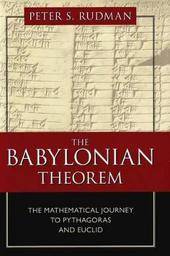
|
The Babylonian Theorem: The Mathematical Journey to Pythagoras and Euclid
Hardback
Main Details
| Title |
The Babylonian Theorem: The Mathematical Journey to Pythagoras and Euclid
|
| Authors and Contributors |
By (author) Peter S. Rudman
|
| Physical Properties |
|
| Category/Genre | History of mathematics |
|---|
| ISBN/Barcode |
9781591027737
|
| Classifications | Dewey:510.9 |
|---|
| Audience | | General | | Postgraduate, Research & Scholarly | | Professional & Vocational | |
|---|
|
Publishing Details |
| Publisher |
Prometheus Books
|
| Imprint |
Prometheus Books
|
| Publication Date |
26 January 2010 |
| Publication Country |
United States
|
Description
In this sequel to his award-winning "How Mathematics Happened", physicist Peter S Rudman explores the history of mathematics among the Babylonians and Egyptians, showing how their scribes in the era from 2000 to 1600 BCE used visualisations of how plane geometric figures could be partitioned into squares, rectangles, and right triangles to invent geometric algebra, even solving problems that we now do by quadratic algebra. Using illustrations adapted from both Babylonian cuneiform tablets and Egyptian hieroglyphic texts, Rudman traces the evolution of mathematics from the metric geometric algebra of Babylon and Egypt - which used numeric quantities on diagrams as a means to work out problems - to the non-metric geometric algebra of Euclid (ca. 300 BCE). Thus, Rudman traces the evolution of calculations of square roots from Egypt and Babylon to India, and then to Pythagoras, Archimedes, and Ptolemy. Surprisingly, the best calculation was by a Babylonian scribe who calculated the square root of two to seven decimal-digit precision. Rudman provocatively asks, and then interestingly conjectures, why such a precise calculation was made in a mud-brick culture. From his analysis of Babylonian geometric algebra, Rudman formulates a "Babylonian Theorem", which he shows was used to derive the Pythagorean Theorem, about a millennium before its purported discovery by Pythagoras. He also concludes that what enabled the Greek mathematicians to surpass their predecessors was the insertion of alphabetic notation onto geometric figures. Such symbolic notation was natural for users of an alphabetic language, but was impossible for the Babylonians and Egyptians, whose writing systems (cuneiform and hieroglyphics, respectively) were not alphabetic. Rudman intersperses his discussions of early math conundrums and solutions with "Fun Questions" for those who enjoy recreational math and wish to test their understanding. This is a masterful, fascinating, and entertaining book, which will interest both math enthusiasts and students of history.
Author Biography
Peter S. Rudman (Tel Aviv, Israel), a retired professor of physics at the Technion-Israel Institute of Technology, is the author of How Mathematics Happened: The First 50,000 Years, which was selected in 2008 as an Outstanding Academic Text by the American Library Association.
|